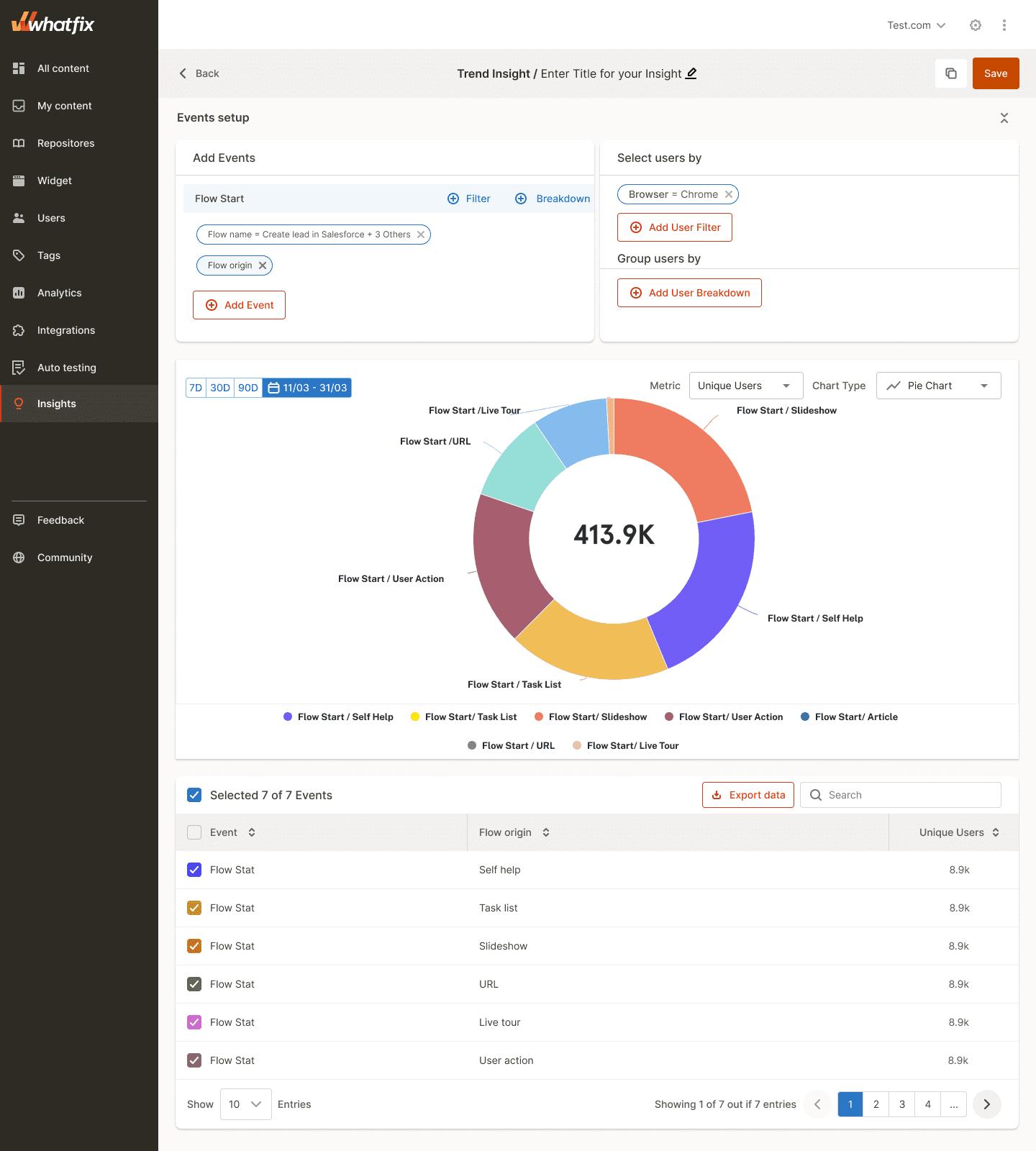37+ Uses Cases for a Digital Adoption Platform (DAP)
A digital adoption platform (DAP) can be used on any application to enable end-users with contextual experiences, like in-app guidance, and support, that drive end-user productivity and helps achieve better business outcomes. DAPs like Whatfix provide organizations with a no-code editor to create in-app guidance and self-help user support experiences such as interactive walkthroughs, step-by-step guidance, task lists, pop-ups, self-help wikis, and more.
In this article, explore real examples of DAP use cases on CRM, HCM, ERP, and other industry-specific enterprise applications, showcasing how DAPs guide end-users through complex digital processes and custom-built workflows. Each example is powered by Whatfix.
Realize the Value of a DAP
Explore Whatfix DAP use cases by business department, application type, or industry.
CRM & Sales Use Cases
DAPs enable sellers with in-app guidance and real-time support on contextual sales processes and workflows, overlaying on any enterprise sales software UI, including CRMs, CPQs, contract management tools, and more. These use cases were easily integrated with heavily customized instances of Salesforce CRM, MS Dynamics, and Oracle CRM.
Before DAP:
- A high number of overdue opportunities in CRM (ie. open opportunities that are past their close date.)
- Sellers lost track of open opportunities and failed to pay attention and close overdue deals, resulting in opportunities being dropped and lost.
- The company lost potential revenue from dropped and lost opportunities due to poor deal management and overlooked close dates.
- Overdue opportunities with dirty and incomplete data led to inaccurate sales forecasting and reporting.
With DAP:
- Reminded sellers of overdue opportunities and opportunities that were <3 days away from the close date with personalized in-app alerts and notifications.
- Guided sellers to a custom report that included all overdue opportunities assigned to them.
- Nudged sellers to save this overdue opportunities report in their favorites for easier access and to drive process adoption.
- 76% of overdue deals were cleared in the first three months of Whatfix implementation, which greatly improved pipeline CRM data quality.
- Reactivated dormant opportunities that significantly added to the active pipeline and potential new revenue.
Before DAP:
- Sellers’ lacked contextual knowledge for each prospect (use case, industry, needs) which led to sales approaches that were generic and didn’t showcase value to each individual prospect.
- Information not accessible for sellers at the moment of need, ie. when interacting with prospects or inside their CRM application.
- Poor lead-to-opportunity conversion affected pipeline generation, eventually resulted in lost revenue.
With DAP:
- Identified specific lead types/personas based on prospect traits such as company size, industry, use case, lead designation, etc.
- Provided key information in-app with smart nudges on each of the identified accounts to the seller.
- Attached persona cards in-app with nudges (by integrating with a knowledge base where they were hosted) to help sellers tailor their pitch to the prospect.
- Higher lead-to-opportunity conversion rates, enabled by more tailored conversations with prospects.
- Increased pipeline value and ultimately uptick in revenue.
Before DAP:
- Sellers lacked knowledge of competitive intel.
- Sellers couldn’t access this information when and where they need it (ie. within their CRM platform), and instead had to find it in their knowledge repositories and drives.
- This led to dropped deals and lost revenue.
With DAP:
- Delivered dynamic seller nudges in the form of smart tips with key competitor info based on competitor names entered in the form field.
- Attached competitive battle card in the in-app nudge (by integrating with the repository where they are hosted) to help sellers access this competitive intel within the CRM.
- Higher deal conversion rates through more robust competitive positioning during the sales cycle.
- Increased deal sizes through differentiated value propositions.
Before DAP:
- Sellers were unaware of new product launches.
- Sellers lacked knowledge of product packaging and those products that can be sold in logical bundles.
- Lost revenue potential by missing out on the opportunity to sell more products through cross-selling and up-selling.
With DAP:
- Highlighted new products and services with in-app nudges that introduced them in the CRM.
- Alerted the sellers with in-app alerts on bundling opportunities right in the deal, and workflow automation guided them to add the relevant products that can be pitched in that specific deal.
- Highlighted product-specific cross & upsell opportunities when the seller was on that deal in the CRM with contextual smart tips.
- Increased revenue from the cross and upsell deals.
- Higher deal sizes through product and service bundles.
- Faster time to value realization from new product and service launches.
Before DAP:
- Sellers entered incomplete data in the CRM, with the biggest factor impacting it being CRM data entry is often considered a time-consuming and low-value activity.
- Sellers lacked the knowledge of requirements and best practices when entering sales data.
- Inaccurate reporting negatively impacted decision-making, often based on incomplete or inaccurate information.
- Lacked predictability in sales forecasting which resulted in poor resource planning, both of which impacted the efficiency and productivity of the sales team.
With DAP:
- Analyzed CRM pages (opportunity, lead, etc.) to identify missing data and inaccurate data.
- Delivered nudges to remind and guide sellers to take the required action to update and correct the data.
- Delivered in-app smart tips and field validations on critical form fields to help sellers enter all required data and in the required format.
- Improved decision-making by identifying patterns and trends in customer behavior, seller performance, and sales process effectiveness.
- Increased competitiveness and revenue potential by improving the efficiency of sales operations.
Before DAP:
- Sellers struggled with the challenges and complexities of enterprise sales.
- New sellers needed time to understand the full scope of products and services, sales cycle patterns, and the various objections thrown from prospect before being productive.
- Long onboarding time-to-productive times led to deferred revenue from new sellers.
- Lost revenue due to sellers’ inability to confidently pitch, handle objections, and respond effectively to prospects.
With DAP:
- Guided sellers through key contextual sales processes in the CRM with in-app flows and guidance.
- Embedded audio snippets within these flows simulated real-life sales conversations with customers, including first outreach calls, objection handling, price negotiations, and more.
- Trained new sellers in a safe and low-stress simulated environment, enabling better knowledge retention and skill development.
- Improved revenue generation potential through efficient sales mechanisms, competitiveness, and responsiveness.
Before DAP:
- Complex product offerings had multiple modules which could be subscribed to separately by customers on its freemium model.
- Customers who signed up for trial versions of specific modules exhibited particular behavior (ie. clicking a button, completing a process, etc.), which was a strong indicator that they were prepared to upgrade to the paid version.
- Sellers missed these signals because they didn’t track them closely and therefore didn’t act on them.
- These ‘signals’ had been identified, but no precise mechanism was in place to help sellers track those signals.
- Lost potential revenue by selling paid versions of application modules due to data silos
With DAP:
- Integrated with Salesforce and its compliance platform.
- Enabled ‘User Actions’ for specific events, which were deemed signals that the customer was prepared to buy the paid version of product.
- Generated a Salesforce report with data on which exact customers exhibited what signals on which product modules. This report was populated with every signal that was logged.
- Delivered in-app nudges to sellers when they logged on to Salesforce, which was linked to this custom report populated with data from customers mapped to them.
- Improved revenue generation potential.
- Enabled sellers to immediately reach out to customers who were interested in upgrading from a freemium to a paid subscription.
Before DAP:
- Retail sellers for paint stores and distributors visited their customers to sell paint-related products.
- The number of customer visits by each seller was directly proportional to the revenue generated by the seller.
- Sales leadership wanted to improve revenue predictability by optimizing sellers’ data entry in the ‘Customer Visit’ module of their CRM.
- The workflow of the Customer Visit module was complex, and sellers often ended up entering incomplete and inaccurate data in the CRM
- Sellers had to propose a trip to managers who then approved it. After the seller completed the trip they reported on it in the CRM with notes, pictures of their product vs. competitors in the stores, etc.
- Poor revenue forecasting accuracy due to incomplete CRM data entry around customer visits by sellers.
With DAP:
- Guided sellers with pop-up notifications in the ‘Customer Visits’ module.
- Delivered step-by-step Flows with instructions on the entire workflow, which guided users to enter critical data on customer visits.
- Helped sellers with smart tips to enter accurate and complete data, such as # of customers per visit, customer tiers, products and services sold, and manager approvals.
- Improved data accuracy and completeness on customer visits, which led to better revenue predictability.
Before DAP:
- Customers and end-users of this B2B SaaS provided need support for its products.
- A team of customer support agents (who were product experts) provided end-user support to customers, specifically on ‘how-to’ queries.
- They recorded and tracked these ‘use cases’ on Salesforce CRM
- AHT and NPS scores of product experts were closely monitored and tracked.
- One specific department had 1500+ experts with performance levels below 25%, which was poor.
- Lack of product and process knowledge among customer support experts led to high AHT and low NPS, resulting in low customer satisfaction.
With DAP:
- Created customer training modules for underperforming support experts hosted in its knowledge repository.
- Captured email ids of 1500+ experts in an Excel sheet that integrated with Whatfix for contextual Flows for specific users.
- Alerts support experts with a pop-up notification of the new training modules. They were required to complete the assessment at the end of the course
- Sent a pop-up notification to these experts on a specific day of the week until they completed the course and the assessment.
- Improved product knowledge for customer support reps, decreased average handle times, and increased NPS of underperforming support agents.
Before DAP:
- Underperformed on upsell opportunities.
- Customers were only pitched an upsell if they met certain criteria that was automatically done in Salesforce.
- Complex CRM workflow for sellers to identify and respond to automatic upsell alerts inside Salesforce.
- Upsell opportunities were overlooked because upsell alerts and notifications were not obvious in Salesforce.
- Poor upsell workflow led to sellers performing upselling opportunity checks themselves.
- Sellers often made mistakes in identifying upsell opportunities, which led to sellers pitching to the wrong customers.
- Poor upsell conversions, which hurt seller performance and made the company miss out on revenue potential.
With DAP:
- Launched a CRM popup message that alerted sellers to specific accounts that met the upsell opportunity criteria.
- Uploaded a CSV to Whatfix that included data on which sellers owned specific accounts, which allowed contextual alerts to appear for specific sellers when their accounts met the upsell criteria.
- Attached to the upsell alert is a link that took sellers to their LMS that included sales enablement content to help sellers make the most effective upselling pitch to the specific customer they’re targeting.
- Increased account upselling success rate 183% in 90 days (from 12% to 34%.)
- Improved seller productivity and efficiency by eliminating the need to manually check accounts’ upsell criteria.
- Improved customer experience, with sellers only reaching out to customers that met certain criteria.
- Improved product line knowledge for sellers.
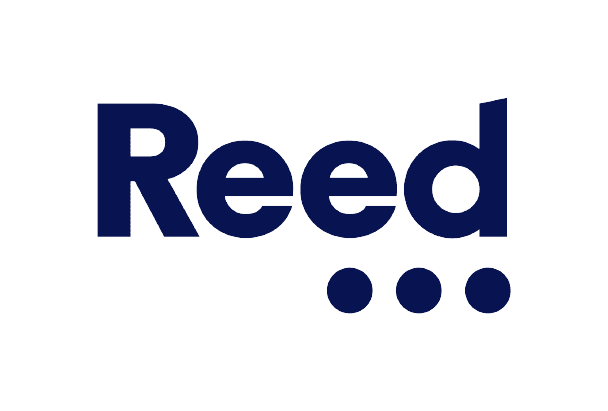
ERP Use Cases
DAP enables ERP end-users on their role-based tasks and workflows across procurement, accounting, supplier management, order requisition, and other ERP-related processes critical to enterprise operations. These examples look at use cases built on Coupa, Icertis, S/4HANA, but Whatfix can integrate with any ERP or procurement application.
Before DAP:
- Complex Coupa workflow for creating a purchase request, which involved a series of steps such as entering the catalog item name, the commodity category, the supplier name, and several other mandatory form fields.
- The “commodity category” field included a dropdown of 100+ categories to choose from.
- High rate of users selecting the wrong category, leading to inaccurate purchase requests.
- Users spending a significant amount of time on each form trying to choose the correct category – often needing additional support.
- Significant time spent on correcting purchase request errors and mistakes.
- Costs incurred by raising incorrect purchase requests.
With DAP:
- Created in-app smart tips for the “commodity category” field, which prompted users with three questions on the type of purchasing order they were creating.
- Based on the user’s response, the number of selectable categories was reduced from 100+ to a handful of options.
- Enabled Coupa users with contextual support to accurately and confidently choose the right commodity category and subcategory.
- Reduced the time-to-completion when creating purchase requests.
- Improved user productivity by minimizing errors in this purchasing process.
- Enabled Coupa users with contextual support to do their jobs more effectively.
Before DAP:
- Complex contract execution process with several tasks and involving multiple stakeholders, which led to lengthy contract execution timelines.
- Required post-negotiation signatures from suppliers and internal stakeholders.
- Required contract owners to navigate across multiple applications (CLM software and e-signature software), leading to a fractured, tedious end-user experience.
- Poor knowledge of contract workflow, as it was an infrequent task.
- Lengthy contract completion time due to complex, convoluted contract workflow.
- Risk of legal complications, unexpected costs, and poor supplier experience due if errors or mistakes occurred (such as creating the wrong signature blocks) in the contract documents.
With DAP:
- Created in-app guidance that enabled contract owners with step-by-step e-signature support to accurately complete their contracts.
- Built cross-application guided experience that enabled contract owners with contextual in-app tutorials to correctly update documents, add the right signature blocks, and send the agreement to suppliers and internal stakeholders.
- Accelerated the time-to-completion of e-signature tasks, which led to faster overall contract execution times.
- Improved their contracts’ legal compliance.
Before DAP:
- Confusion about what buying channel to select for non-procurement team members supporting the purchase order process.
- Non-compliant orders due to employees requesting non-catalog items and spend not being tracked against contracts.
- Non-procurement team members were unaware of the proper buying channel to select for orders, often resulting in ad hoc, open-text, non-catalog order requests instead of searching and selecting pre-defined catalog items.
- When a non-catalog request is raised, the ordering process becomes much more complex and requires customization, requiring the procurement team to intervene to fix the request.
- Lengthy order approval times and delayed purchase orders due to non-adherence to procurement processes and tasks.
- Inaccurate orders were frequently created and sent to suppliers.
- Non-compliant purchase order and requisition process.
With DAP:
- Created an in-app pop-up alert when a user clicked on the “add a non-catalog item” button.
- Guided users through the catalog selection process to help them find and select the correct catalog items.
- Enabled users with an interactive walkthrough prompted by an in-app pop-up that provided step-by-step assistance for users to create the correct type of requisition.
- Enabled non-procurement team members with contextual guidance to choose the right buying channel, follow their contextual procurement process, and complete their tasks.
- Improved purchasing compliance, enabling catalog requisition spending to be tracked against contracts.
- Accelerated order requisition approval time and purchase order release to suppliers.
Before DAP:
- Duplicated requisitions created for the same suppliers by different end-users across geographies, locally from their ERPs
- Economies of scale not leveraged and purchase spend was higher
- Overlapping requirements for the same purchasing item depending on the department making the request.
- Purchasing spend increased significantly due to the lack of economy of scale.
With DAP:
- Enforced centralized procurement processes by alerting end-users to combine duplicate requisitions when possible instead of creating new requisitions.
- Nudged end-users in their local ERPs towards the right process action to combine applicable requisitions to create an RFP/Contract or Purchase Order (PO).
- Provided in-app guidance on SAP S/4 HANA Fiori (Web), SAP S/4 HANA GUI (Desktop), and Fiori
- Created in-app guidance that provided support on how to search for all possible requisitions that match a need, how to combine them, and what follow up action items must be completed.
- Cost Efficiency: By consolidating purchases, the company negotiated better pricing and discounts, as well as reduced transaction costs associated with multiple procurement processes.
- Streamlined Process: Creating a single PO, RFP, or contract for multiple requisitions eliminated the need for separate approvals, negotiations, and paperwork for each individual requisition.
- Improved Supplier Relationships: When suppliers receive larger orders, they may be more willing to offer better terms, prioritize delivery, or provide additional value-added services.
- Enhanced Visibility and Reporting: By selecting all applicable requisitions, the company gained better visibility into your organization’s purchasing activities.
- Compliance and Governance: Consolidated requisitions into a single PO, RFP, or contract promoted compliance with internal policies and external regulations.
Before DAP:
- Lacked end-user documentation and guidance for common issues and processes in SAP S/4HANA
- End users needed to exit the application to troubleshoot errors constantly, negatively impacting productivity.
- Frequent delays on time-sensitive processes due to a lack of understanding by end-users.
- Negatively impacted end-user productivity.
- Ignoring or missing errors led to cascading impacts.
With DAP:
- When the end-users encounter an error (like a quantity mismatch between PO & GR), Whatfix understands the error and provides the user an in-app popup that provides contextual support and guides them to the next action.
- Enables end-users with step-by-step guidance that is triggered by this popup.
- Reduced time-to-resolution for SAP issues, deflected SAP-related support tickets, and overall improved end-user productivity with self-help support.
Before DAP:
- The procurement team identified preferred suppliers and sources for each commodity code.
- Infrequent or casual buyers were unaware of preferred suppliers for ad-hoc requests or when non-catalog items and services were not selected.
- Missed opportunity to leverage pre-negotiated terms and discounts from a preferred supplier, increased risk of fraud from an unknown supplier, and increased cost.
With DAP:
- Integrated Coupa with user documentation that listed preferred suppliers for each commodity code.
- When an existing preferred supplier matches a commodity code, the end-user requesting the order is presented with a Smart Tip that has a link to the preferred supplier list.
- Trusted Relationship: Selecting a preferred supplier ensures that you are working with a known entity that has already proven its capability to meet your organization’s requirements and expectations.
- Efficient Communication: Dealing with a preferred supplier means that there is already an established line of communication, making it easier to convey specific requirements, negotiate terms, and resolve any issues that may arise during the procurement process.
- Quality Assurance: By choosing a preferred supplier for non-catalog requests, you increase the likelihood of receiving consistent quality, reducing the risk of receiving subpar or unsatisfactory goods or services.
- Pricing and Cost Benefits: Preferred suppliers often offer competitive pricing and favorable terms due to the ongoing relationship with your organization.
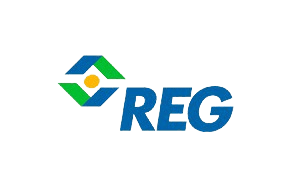
Abby Essing, Sr. Manager, Operations Services at Renewable Energy Group, Inc.
HCM & HR Use Cases
DAPs power HR transformation by enabling HCM end-users (admins, managers, and end-user employees) on core HR processes, including new hire onboarding, learning and development, performance management, benefits management, recruiting, and more. These examples look at use cases built on SuccessFactors, Workday, and Bullhorn, but Whatfix can integrate with any HCM, ATS, LMS, performance management, and other HR-related software.
Before DAP:
- People managers relied on HR and IT for support to complete performance reviews.
- People managers across the organization required additional custom training on the performance review process.
- People managers not familiarized with HCM application and interface due to performance reviews only happening a few times a year, and the HCM going through multiple changes and updates.
- Reduced employee engagement due to performance review delays.
- High volume of support tickets during the performance review cycle.
- Increased training costs due to recurring performance review training needs from a globally distributed workforce.
With DAP:
- Created in-app pop-ups that prompted a step-by-step tour of the performance review process for people managers.
- Created “how-to” documentation and FAQs that were housed in an in-app Self-Help wiki for easy discoverability and troubleshooting.
- 30% reduction in performance-review-related support tickets within six months.
- $500,000 saved in training costs due to not needing annual additional performance-review training and support in the first six months.
- Improved performance review process adherence & data integrity.
- Increased managerial confidence in application navigation.
Before DAP:
- Limited visibility into the benefits open enrollment open timeline.
- Lacked the ability to remind and nudge employees to complete benefits enrollment.
- Inconsistent and low rates of enrolment completion entire company.
- Increased IT support tickets on HCM support team during open enrollment, which weighed down the HCM support team.
- Lost coverage for employees with missed enrollment deadlines, leading to upset employees and a poor overall employee experience.
With DAP:
- Created a pop-up notification inside all employees’ email client and HCM, with an open enrollment countdown and deadline details.
- Linked the pop-up’s CTA to the benefits enrollment page, which included an in-app flow that guided employees through the enrollment process.
- Launched smart tips and field validation on the enrollment page to ensure accurate data entry in critical fields such as employee address, bank details, beneficiary, etc.
- Resolved all employee support questions on the enrollment process with in-app Self-Help.
- Re-focused 20+ member support team on more critical activities.
- Improved benefits enrollment rate across the company.
Before DAP:
- Poor adoption of SAP SuccessFactors among hiring managers, which resulted in poor awareness of the hiring and recruitment processes.
- Relied heavily on the HR & IT support teams to complete key hiring and recruitment tasks such as creating job descriptions, and critical fields such as position category, compensation, requirements, and qualifications.
- A high number of recruitment-related support queries for HR and IT support teams.
- Increased support costs and lower support productivity due to large amount of recruitment process questions.
- The inability for hiring managers to conduct basic hiring and recruitment tasks without HR support.
With DAP:
- Provided in-app step-by-step walkthroughs of the recruitment process triggered by a pop-up notification when a hiring manager entered SuccessFactors.
- Created flows on all key recruitment processes and linked them within the Self Help widget for hiring managers.
- Integrated Self Help with existing internal knowledge base, enabling hire managers to find documentation, help articles, and support links within the application, and without IT support.
- Improved hiring process adherence and recruitment data quality.
- Reduced volume of recruitment related support queries.
- Improved adoption of HCM application for hiring managers.
Before DAP:
- High number of inactive candidates in the recruitment pipeline, without recruiters acting on or updating recruitment prospect in HCM.
- High number of recruitment candidates led to candidates falling through the cracks, losing out on top talent, and creating long time-to-hire timelines.
- Lost high number of quality hires due to inactivity.
- Poor recruitment data quality resulted in inaccurate forecasting and workforce planning.
With DAP:
- Created personalized pop-up alerts in the HCM for recruiters who had inactive candidates in their pipeline, and reminded them to take action.
- Launched HCM smart tips on SuccessFactors’s candidates page, which contained a list of candidates who needed action and their respective statuses.
- Sent nudges to recruiters whenever there hadn’t been am action on a candidate for a certain period of time.
- Reduced time-to-hire for new employees, improved quality of new hires, and improved recruitment pipeline data quality.
Before DAP:
- Delayed submission of the employee self-assessment prolonged the entire performance review assessment cycle.
- Poor completion of self-reviews due to employees ignoring or forgetting to submit a self-review.
- High dropoff rates in the performance review process due to a lack of process awareness.
- High amount of low-quality and incomplete performance reviews.
- Delayed completion of performance review resulted in financial impact for the organization.
- Delayed submission and poor data quality of reviews caused multiple review iterations that affected the productivity of all employees and managers.
- Slowed the bi-annual performance review process and caused delays with pay assessments and title changes.
With DAP:
- Leveraged product analytics to identify friction and dropoff points in the performance self-review process, and to identify what cohorts of employees (ie. what teams) were failing to complete their reviews.
- Captured page-level journeys of employees to understand which sections of the self-assessment process were visited and how much time was being spent on the reviews.
- Discovered a significant drop-off at the self-rating stage, specifically goal and competency ratings and that the sales team had higher than average incompletion.
- Implemented an in-app beacon/tooltip on the rating widget, only for employees of the sales team.
- Attached to the Beacon was a link that provided guidance to sellers with further instructions on how to properly finalize the self-review process.
- Improved self-assessment completion rate in a shorter amount of time, which led to quicker completion of performance reviews across all teams.
Before DAP:
- Onboarded a large number of recruitment consultants every week.
- Lacked the contextual onboarding and training needed to become proficient in Bullhorn promptly.
- Longer onboarding time and poor training led to new recruiters not being able to use Bullhorn correctly or to its full potential.
With DAP:
- Created in-app guidance and Flows in key recruitment processes for more contextual onboarding.
- Supported recruiters with Self Help embedded on Bullhorn that launched in-app Flows.
- Smart tips on critical form fields were added to improve data accuracy.
- Integrated company’s process documentation and knowledge base repository within Self Help to provide on-demand information such as links to candidate screening forms, Bullhorn training courses, etc.
- Improved time-to-proficiency and self-sufficiency post-onboarding for new recruitment consultants.
- In 5 months of process enhancements with Whatfix, more than 85% of the new recruitment consultants at a leading Staffing Solutions provider became proficient with Bullhorn’s key processes and were self-sufficient in using the application for their recruitment tasks.
Before DAP:
- Poor knowledge retention for recruitment constants due to one-time instructor-led training sessions on Bullhorn.
- Lacked reinforcement training and on-demand support for Bullhorn.
- Led to slower recruitment and placement times due to the ineffective use of Bullhorn
- Increased support cost fueled by how-to queries on Bullhorn from recruitment consultants.
With DAP:
- Reinforced classroom training material within Bullhorn, including a Task List of key to-do’s that guided recruiters through a checklist of training materials, process flows, policies, etc.
- Minimized content creation effort by exporting Whatfix Flows as PDFs.
- Used Whatfix Analytics to understand process journey and friction points. Updated classroom training material to address those gaps.
- Provided post-training self-help support inside Bullhorn.
- Improved adoption of Bullhorn by recruitment consultants.
- Reduced support cost by driving down how-to support queries.
- Reduced training content creation time and effort by exporting Whatfix Flows to PDFs.
Before DAP:
- Mailed physical benefits overview packets to all employees during the enrollment period.
- High return-to-sender rate, with 200,000+ packets returned because of inaccurate or outdated employee address information in Successfactors
- Risked compliance issues and poor employee experience due to employees failing to receive their benefits overview packets.
- Significant costs were accrued due to many packets returned to send, which required additional HR resources.
With DAP:
- Reminded employees to verify and update their home addresses with a popup notification.
- When clicked, the popup prompted step-by-step guided instructions with smart tips that walked employees through updating their home addresses in SuccessFactors.
- Reduced costs of mailing physical benefits package overview, improved deliverability of benefits package mailer, and improved employee personal information data accuracy.
Before DAP:
- Transformed outdated HR legacy applications and processes with Workday HCM to support 150,000+ employees.
- Required testing for 150+ HR-related business processes that spanned different types of employees and HCM end-users.
- Required extremely manual assignment of individual test cases to 1,200 testers, as well as collecting feedback post-test for each process.
- Significant time and resources from HR and IT teams were required to assign test cases and collect feedback.
- Risked creating poorly designed (or broken) HCM experiences and workflows due to human errors in the user testing process.
- Slowed change implementation, delaying HCM ROI.
With DAP:
- Created a welcome popup for every individual tester that explained the testing procedure.
- Enabled the testers with an in-app task list that contained an introduction video to the testing process, a link to a spreadsheet with all test case assignments, and a survey link to submit feedback.
- Auto-populated test case details based on the user ID entered in a form field.
- Provided self-help support for every Workday test case, which provided step-by-step instructions in a Self Help overlay widget.
- Once the test is completed, the users click on the feedback form link in the task list and provide their feedback on the test case and guidance provided by Whatfix.
- Accelerated Workday implementation significantly by significant time in assigning test cases and collecting feedback from testers in-app and ensured that its Workday processes were accurate and simple to use.

Colleen Behnke, Learning and Performance Specialist, Sentry Insurance
Banking Use Cases
DAPs power financial services and banking transformation by enabling bankers, loan managers, brokers, financial advisors, and account holderswith in-app guidance and self-service experiences across digital banking applications and processes. These examples look at use cases built on nCino, but Whatfix can integrate with any loan management software, custom-built banking portal, or any banking-related software application to improve customer experiences in banking.
Before DAP:
- Complex loan underwriting process in nCino.
- Lengthy underwriting process due to a lack of process knowledge and a large volume of data that needs to be entered for loans.
- Required a cross-application process that needed managerial approval for each loan and interations were required for each loan.
- Increased time to create credit memos and approve loans has resulted in a worse customer experience.
- Reduced productivity and increased data errors due to lengthy, back-and-forth between the underwriter and approving manager for each loan.
With DAP:
- Leveraged Whatfix Analytics to understand user journey to analyze and identify product usage insights such as entry points, dropoff areas, feature adoption, and overall engagement.
- Used cohort Funnels to identify the most common friction points within different nCino processes and workflows.
- Gathered insights on the variance between the most optimal user journey for each workflow and the actual journey adopted by users.
- Identified user cohorts with the most variance from the most efficient user path.
- Created in-app Flows to nudge users to take the preferred journey to complete the credit memo creation process.
- Delivered smart tips to drive data entry accuracy.
- Accelerated credit memo creation process adoption which resulted in a faster loan approval cycle and better customer experience.
- Improved data quality of credit memos and overall underwriter productivity.
Before DAP:
- Errors in loan documentation & verification process.
- Increased the number of support tickets from loan agents and customers and reduced resources available for solving more complex support issues.
- Delayed loan verification due to a lack of updates on regulatory changes and updates.
- Risked company reputation due to nonadherence to regulatory changes and loss of borrowers due to lengthy loan approval times.
- Poor borrower experience due to loan delays due to data entry errors and long approval processes.
With DAP:
- Alerted underwriters of loan policy and regulatory changes with in-app pop-ups and beacons.
- Nudged customers and underwriters with in-app Flows that guided them through the loan approval process on the most efficient journey.
- Drove data entry accuracy with in-app field validations, smart tips, and task lists.
- Reduced errors in the loan document creation and verification process.
- Scaled loan processing due to a more efficient nCino process adopted by underwriters.
- $150k saved by enabling underwriters with a self-help experience and just-in-time training guidance for quick loan processing.
- Prevented company reputational risk from mitigating loan non-compliance.
Before DAP:
- Lack of structure and support during the change and digital transformation transition from a legacy desktop application to a new, cloud-based banking application.
- Slow customer data processing due to digital knowledge gaps and slow adoption rates.
- Lack of department-specific process support for contextual team needs.
- Lack of reskilling and upskilling for older employees who had used the legacy systems and were unfamiliar with and resistant to new SaaS platforms.
- Delayed ticket time-to-resolution due to large volume of support tickets from loan agents and customers on basic digital banking processes and tasks.
- Delayed loan approvals due to a lack of application knowledge and resistance to new processes.
- Longer approval times led to customer (borrower) frustration.
With DAP:
- Nudges users with process-specific Flows to guide them through the preferred journey to complete various in-app processes.
- Supported loan origination teams with role-based, contextualized training on complex industry-specific banking processes.
- Enabled existing customers to seamlessly transition to nCino with tailored and targeted self-help content built with usage analytics.
- Improved nCino adoption led to the growth of digital deposits and new loan accounts.
- Faster employee time-to-proficiency on nCino, reduction in nCino support tickets from employees and customers, and improved loan process efficiency.
Before DAP:
- High amount of user dropoffs.
- Low online deposit and new loan account creation adoption
- High volume of support tickets when onboarding customers to online banking portal that overwhelming support team with a high volume of customer support tickets on simple tasks such as resetting passwords and how to open new accounts.
- Insufficient user onboarding and support resulted in long time-to-value and poor adoption of the new customer banking portal.
With DAP:
- Supported customers with an in-app, self-help wiki that organized support content and FAQs that was segmented to specific types of end-user customers (ie. Self Help was populated contextually depending the type of customer – loan account, checking account, etc.)
- Decreased the need for traditional live training sessions and replaced them with Self Help.
- Navigated change more efficiently with on-demand self-help support.
- Drove client adoption with in-app contextual guidance, product-led onboarding, continuous training, and self-service support.
- Resolved 80% of customer support issues with Self Help.
- Drove awareness and adoption of its Self Help, increasing client engagement and productivity 30%.
- Decreased customer onboarding and time-to-adoption by 60% with in-app guided onboarding and self-service support.
Kalyana Sritharan, Lead of Product Strategy, Digital Business & Customer Experience
P&C Insurance Use Cases
DAPs power P&C insurance transformation by enabling claims agents, underwriters, and all insurance employees and policyholders with in-app guidance and real-time support across digital insurance applications and processes. These examples look at use cases built on Duck Creek and Guidewire, but Whatfix can integrate with any P&C insurance, life insurance, claims management, and industry-related software applications.
Before DAP:
- High reliance on IT team to resolve a high volume of “how-to” related support questions from the customer service team on application-related questions.
- Low platform adoption and navigation challenge due to a lack of usage.
- Lack of process standardization led to inconsistency in customers’ journeys and inconsistent data entry.
- Poor CSAT and NPS scores due to inconsistent customer experience and long time-to-resolution times, as well as overall low customer service team productivity
With DAP:
- Launched a contextual self-help wiki based on state and policy type along with multi-format content for 24/7 assistance to the customer service team.
- Created smart tips inside the application to incorporate state-specific guidelines and for rare events such as a natural disaster.
- Launched smart tips with ‘call closing steps’ for the customer service team to validate all data points were entered and next steps were defined,
- Enabled customer service team with employee self-service resolution, reducing reliance on the help desk and allowing the customer to support team to focus on more unique support issues.
- Accelerated time-to-productivity of new customer service reps, 1.25x ROI from the customer service team application, and 10% reduction in training time of the customer service team.
Before DAP:
- Claims adjusters were unaware of new and existing state laws during claims settlement.
- High claims processing and settlement time-to-resolution.
With DAP:
- Launched Self Help that included real-tie support access to regulatory information regarding procedural needs and compliance resources for claims adjusters.
- Create in-app smart nudges for state-specific claims regulation and on what to do in scenarios like rare natural disasters and “act of God” events.
- Saved $193k through improved claims settlement compliance with state laws.
Before DAP:
- Customer service reps committed many errors while gathering customer inputs during the first notice of loss (FNoL).
- Lack of compliance required frequent oversight and reminders for adjusters while processing claims.
- Slow claims processing and settlement time.
- Lack of awareness of critical information needed from customers during FNoL for efficiently processing claims.
With DAP:
- Used Whatfix Analytics to identify error-prone processes and tasks that added slow processing turnaround times (i.e., entering vehicle information when calculating claim limits on different coverage types).
- Deployed smart nudges and data validation to ensure all required fields and information were entered correctly (ie. customer service reps were nudged to enter certain fields that helped process claims accurately; customer-facing smart nudge that prompted them to file a first information report (FIR) in case of theft.)
- Improved processing by launching Smart Tips that ensured the relation to the insured party was marked accurately during FNoL.
- Create in-app automated flows for repetitive and manual tasks. Whatfix performed the required steps, requiring minimum or no human intervention, which reduced data entry errors.
- Improved claims processing time-to-resolution and reduced claims leakage.
- 6x ROI from better application adoption and usage and saved $443k by reducing data entry errors in the first 8 months of Whatfix launch.
Before DAP:
- High variance in workers’ compensation laws from state to state.
- Difficult for claims adjusters to keep be aware of and keep track of each state’s workers’ compensation forms, rules, timelines, etc.
- Documentation of each state’s laws and regulations was stored on a SharePoint site, which lacked the UX accessibility and organization to easily find what users were looking for. This required users to manually search for each state’s contextual process guide for every claim.
- Frequent errors in worker compensation claim adjustments.
- Costs and losses for the insurance provider due to claim rejects, inaccurate claims, adherence to compliance laws, and poor policyholder experience.
- Unproductive claim agents with poorly optimized adjustment processes and workflows.
With DAP:
- Created “Smart Tip” that appeared when claim adjusters entered or interacted with the “policy state” field on the digital claim form.
- Linked the “Smart Tip” to the state-specific documentation in SharePoint that was entered in the “policy state” field.
- Reduced errors in processing and adjustments for workers’ compensation claims.
- Improved claims adjusters’ productivity by enabling them with real-time support and a better digital claims processing experience and workflow.
- Accelerated approval time for worker-compensation-related claims.



Colleen Behnke, Learning and Performance Specialist, Sentry Insurance
Pharma Use Cases
DAPs empower pharmaceutical transformation by enabling end-users with in-app guidance and self-help support to employee end-users of pharma-related software applications and digital processes to support quality assurance, compliance, and more. These examples look at use cases built on Veeva QMS, Trackwise, and ETQ Reliance, but Whatfix can integrate with any quality management system, regulatory information management (RIM) system, and any enterprise application used at a pharmaceutical and life science company.
Before DAP:
- Medical equipment manufacturing company employees filed eMDR (Electronic Medical Device Reporting) reports on Trackwise that were first reviewed internally and then sent to the FDA for approval.
- Complex forms where required data was dynamic based on inputs in previously filled forms, with certain fields being FDA-mandated and others being optional.
- High rate of critical data-entry errors in spite of internal review process, leading to the FDA rejecting reports at a high rate – resulting in significant time and cost spent in re-filing the reports.
With DAP:
- Intelligent in-app Smart Tips nudged end-users at key moments in the process and alert them to required fields and provided Field Validation to ensure proper format was used.
- Automatically blocked and rejected all reports if required fields were empty.
- Created a Pop-Up notification to remind specific end-users that had upcoming deadlines to remind them to submit their reports and forms.
- This led to a reduction in reports rejected by the FDA, minimized user errors in the application process, and improved overall employee productivity.
Before DAP:
- Quality issues and critical regulatory breaches were often not
identified or addressed timely manner, as it lacked a systematic approach to dealing with these issues. - This led to regulatory fines due to non-compliance.
- This also resulted in company-wide compliance risk, quality concerns with their products, operational inefficiencies, and legal liabilities.
With DAP:
- Enabled Stepwise QMS end-users with in-app guidance that assisted Q/A teams with Smart Tips and Flows on choosing the correct record ID and escalation criteria based on issue types.
- Create dSmart Tips that provide moment of need support to employees to better determine the level of escalation, who needs to be alerted, auto-populate product impact, track results, and check escalation outcomes.
- This in-app guidance led to a 50% reduction in end-user process and QMS data-entry errors and a 50% improvement in process compliance.
- Enhanced overall product quality and supported continuous product improvement.
- Improved quality-related issues process that eliminated production delays and improved overall operational efficiency.
Before DAP:
- Lacked clear procedures & SOPs for triage and quality control.
- Delayed complaint resolution due to end-user workflow errors and inconsistent processes.
- No system for categorization & prioritization during triage resulted in missing due dates and overlooking severe risks.
- Complex quality management processes.
- Always changing regulatory requirements and evolving tech landscape.
- These quality-related workflow issues and digital friction led to regulatory compliance issues, increased cost of quality & operation costs, increased legal liability, negative brand impact, and delayed drug releases.
With DAP:
- Created Flows that provides in-app guidance for end-users from the quality event moment to closure.
- Provided in-app Smart Tips that provided moment-of-need support on how to prioritize different complaints based on risk assessment, which included resolution best practices and examples.
- Collected end-user analytics to proactively identify areas of friction and created new documentation to assist users in these error-prone friction points.
- Resulted in a 50% reduction in end-user triage and quality control errors and a 50% improvement in process compliance.
- Accelerated quality complaint and event time-to-resolution with new triage categorization process.
- Enabled quality control employees with real-time support and learning by doing, improved end-user productivity and created a frictionless Veeva QMS experience.
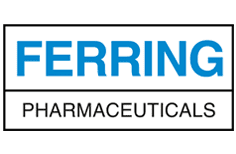

Sheila Dusseau, Head of Global Legal Operations at Ferring
What leaders need to know about digital adoption
Whatfix DAP Features
Across these DAP use cases, we referred to various Whatfix features. Here, learn more about each of these DAP features to understand how organizations are enabled to create frictionless in-app experiences.
Flows
Flows (commonly known as interactive walkthroughs) enable end-users with step-by-step guidance on their contextual digital processes and workflows.


Pop-Ups
Pop-Ups overlay on the entire application screen and require the end-user to engage with the Pop-Up to close it. Pop-Ups can welcome new end-users to an application, announce company or team news, alert end-users to a process change or new feature, and more. With Pop-Ups, organizations can embed a video, link a third-party resource, or prompt an in-app guided experience.


Self Help


Smart Tips
Smart Tips provide additional context and information to end-users with in-app tooltips. Smart Tips appear as pop-ups over on application modules or elements and can include links to additional information (like SOPs or best practices) and can prompt in-app guidance.


Task Lists
Task Lists are end-user checklists used during application onboarding and times of change, providing end-users with a list of mandatory or recommended first action items to complete in an application, such as setting up an account, engaging with the product tour, completing a first task, or using a specific feature. Task Lists help reduce time-to-proficiency for new users and guide them to their “aha!” moment.
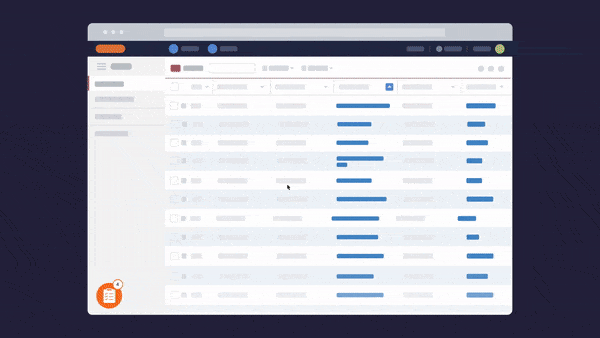

Surveys
Whatfix Surveys provides a no-code solution to creating and launching on-brand in-app surveys to collect end-user feedback. Surveys can be simple eNPS/NPS surveys, gather feedback on recent changes, run post-training and onboarding surveys, and more.


Analytics
Whatfix Analytics provides a no-code event tracking solution to monitor and analyze end-user behavior across your software and digital processes. Track in-app clicks, page visits, mouse interactions, and more to identify areas of end-user friction, optimize digital processes, gain an understanding of feature and workflow adoption, and use data to make software and technology-related decisions.
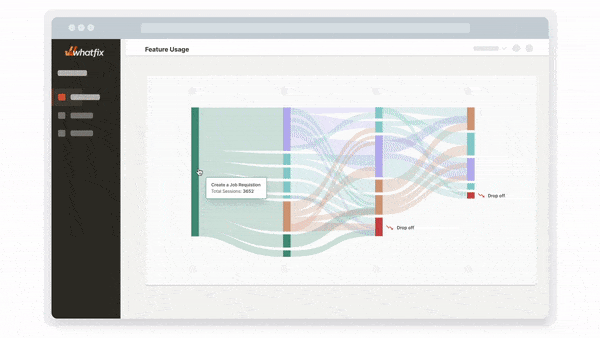

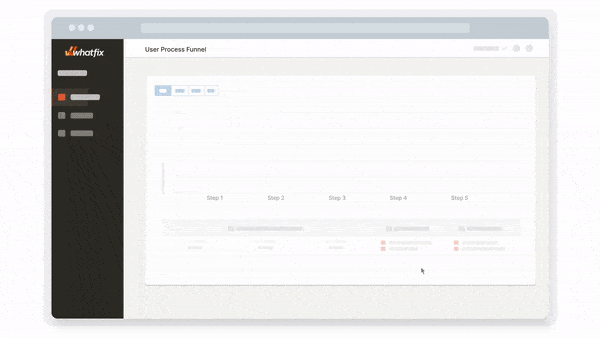

Enterprise Insights
Enterprise Insights enables organizations with the ability to track, visualize, and analyze applications, workflows and processes across your application stack, as well as adoption rates and engagement data across your enterprise and its department units. This data enables IT and business leaders to gain visibility into software license utilization and adoption, as well as end-user engagement metrics, of all business-critical enterprise applications and processes. This empowers enterprises to remove productivity blockers, create frictionless digital workflows, and drive overall efficiency in your organization.
